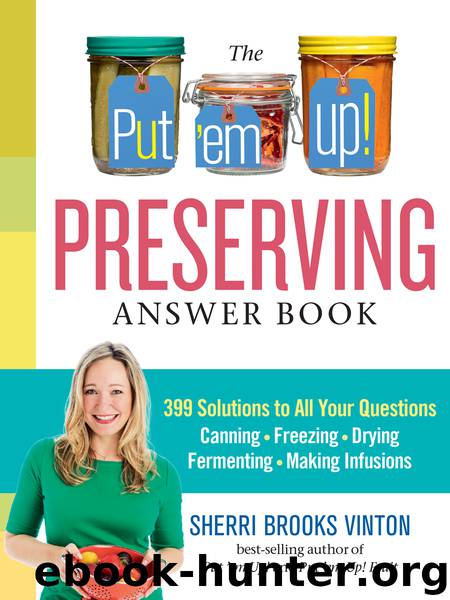The Put 'em Up! Preserving Answer Book by Sherri Brooks Vinton

Author:Sherri Brooks Vinton
Language: eng
Format: epub
Tags: preserving, canning, food, pressure canning, refrigeration, freezing, drying, fermentation, fruits, vegetables, answers, harvest, safely, Q & A, reference
Publisher: Storey Publishing, LLC
Published: 2014-04-04T17:29:03+00:00
Q: My friend got burned by the steam in her pressure canner. How do you keep that from happening?
A: Most likely, your friend opened the canner before it was completely cooled. You must allow your canner to return to zero pressure before opening it. Make sure to remove your gauge to allow excess steam to escape before removing the lid. Even then, it’s always advisable to tip the lid away from you to avoid any steam from being released toward your face or body. Never force-cool a pressure canner by pouring cold water over it or wrapping it with cold towels.
Q: What does it mean to exhaust or vent your canner? Why is it important?
A: Exhausting your canner, also called venting, allows the pressure in your canner to become constant before you begin to measure and regulate it. It’s a simple part of the pressure-canning process that ensures your readings are accurate. After the lid is closed on your filled canner and it is placed over a burner, steam will begin to build and escape through the vent pipe. This will start slowly at first but in a few minutes, the steam will form a distinct cone shape as it is released through the vent pipe. Once the cone has formed, regulate the heat to maintain a steady, robust flow of steam for 10 minutes, exhausting the canner. After this step, you can put your weighted or dial gauge in place to reach the appropriate pressure.
Q: If I double the number of jars that I am processing, do I double the amount of time they are in the canner?
A: No. Processing times are determined by the recipe and the size of the canning jar. The number of jars in the canner, even if you are processing double layers of jars, is irrelevant.
Q: I’m in a hurry. Can’t I just submerge my pressure canner in some cold water to cool it down quickly?
A: It is crucial that you allow your pressure canner to return to zero pressure gradually and naturally. Never submerge it in water or apply cold towels to hasten the process. Doing so can damage your pressure canner and cause the jars inside to leak their contents or crack.
Q: What are the basic steps to pressure canning?
A: Pressure canning and the boiling-water method share a lot of the same steps. The difference lies in how you process the jars. Rather than submerging the jars in boiling water, as you would with the boiling-water method, pressure-canned jars are subjected to a highly pressurized environment that raises the temperature above the boiling point. If you have ever used the boiling-water method to process food, you will find pressure canning an easy leap to make. Even if you’ve never canned food before, pressure canning is pretty straightforward. Here’s how it goes:
1. Wash your equipment and jars. You don’t need to use any special cleansers, but it’s important that all of your equipment be clean. Wash everything in hot, soapy water and arrange on a clean tea towel.
Download
This site does not store any files on its server. We only index and link to content provided by other sites. Please contact the content providers to delete copyright contents if any and email us, we'll remove relevant links or contents immediately.
| Cheese & Dairy | Chocolate |
| Fish & Seafood | Fruits |
| Herbs, Spices & Condiments | Meat & Game |
| Natural Foods | Pasta & Noodles |
| Potatoes | Poultry |
| Rice & Grains | Vegetables |
The Sprouting Book by Ann Wigmore(3543)
Better Homes and Gardens New Cookbook by Better Homes & Gardens(3524)
Trullo by Tim Siadatan(3378)
Super Food Family Classics by Jamie Oliver(3366)
Hedgerow by John Wright(3274)
Panini by Carlo Middione(3249)
Bread Revolution by Peter Reinhart(3082)
Sauces by James Peterson(3050)
Jam by Jam (epub)(3021)
Ottolenghi - The Cookbook by Yotam Ottolenghi(2869)
Oh She Glows Every Day by Angela Liddon(2727)
My Pantry by Alice Waters(2542)
Hot Sauce Nation by Denver Nicks(2450)
The Culinary Herbal by Susan Belsinger(2429)
Veg by Jamie Oliver(2408)
Wanderlust by Jeff Krasno(2225)
Meathooked by Marta Zaraska(2220)
The Art of Making Gelato by Morgan Morano(2216)
Basic Illustrated Edible and Medicinal Mushrooms by Jim Meuninck(2187)
